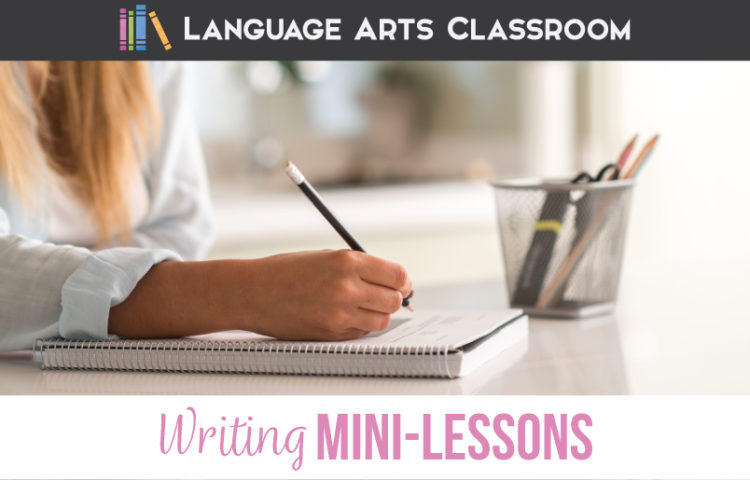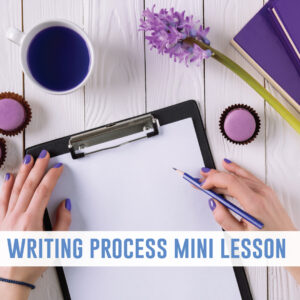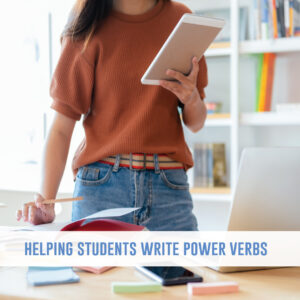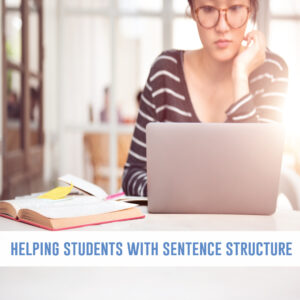Writing mini-lessons? Today, I’m reflecting on the larger writing process that I teach with freshmen and sophomores. I’ve realized that within my writing units, I primarily teach six writing mini-lessons.
I teach writing throughout the entire semester with various projects after reading or an important discussion. Sure, we complete formal, researched papers. I do front-load information and provide expectations ahead of assignments. Still, as I encourage my writers, I’ve realized that I use min-writing lessons at different times throughout the semester.
I don’t present these lessons in a particular order, but by the end of the semester, we’ve worked through these smaller lessons. With high school writing lesson plans, flexibility is key.
My writing bundle contains various mini-writing lessons. Below, I’ve detailed my ideas so that you can make them your own. Writing mini-lessons (for high school students) can work in most writing curriculums, with writing workshop, and alongside mentor texts.
Not only do the writing mini-lessons boost student understanding allow me to differentiate, but they also ease my grading. Classes experience targeted practice and therefore, polished products. My grading is easier especially when we move to larger papers.
Overall, these writing mini-lessons benefit everyone.
How do you structure a successful writing mini lesson?
A successful writing mini-lesson should follow a clear structure: start with a hook to engage students, introduce the writing concept or skill, provide examples and explanations, allow for guided practice and independent writing time, and end with a wrap-up and reflection on what was learned.
Here are six.
Writing Process Mini-lessons
Cover expectations, definitions, and the writing process with a presentation and digital note sheets. Show characteristics of effective writing.
Boring? Nope: when I cover basics, I emphasize with students that I want us all to know expectations. Students arrive in my classroom with different experiences and domain-specific vocabulary. Instead of assuming that classes know my expectations, I clarify ideas with a quick presentation that outlines the basis of the writing curriculum.
After reviewing the writing process, implement paragraph writing to familiarize your classes with your expectations and manner of feedback. Plus, short assignments are a great way to implement the writing process quickly.
“One” Focus
Writing can overwhelm students, and one of my mini writing lessons is a focus on “one” idea students can accomplish. Since I provide feedback ahead of the final draft, I take into consideration the “overwhelm” that some writers can face. Since writing is a personal endeavor, students can easily become defensive about corrections. I feel that one of my jobs is to support the writer while showing the writer ways to improve the message.
With the “one” focus, everyone can easily tackle one area for improvement, see success, get excited, and move to working on more areas. As I work with a anyone, I give one piece of feedback and ask the student to return. You can read more ideas about feedback, but basically, I ask students to look at one area for improvement. For instance:
- Sentence variety.
- Transition words.
- Topic sentences.
- Integration of sources.
- Word choice.
And on! If I feel that a students is particularly overwhelmed, I will focus that student on one sentence. I keep the power of one in mind, and when students sense accomplishment, they almost always begin working on other areas. My conference cards align with the goal of one, and allow for private feedback.
Verb Focus, Grammar
Another writing mini-lesson focuses on verbs. With rough drafts, classes typically fill their papers with linking verbs and basic verbs (have, does). A rough draft shouldn’t be perfect, so I always emphasize that these verbs are perfect for the rough draft. After students work through their papers a few times, focus on verbs.
Teach young writers to leverage the power of verbs. Verbs drive a sentence, and verbs can provide an image that adjectives and adverbs can’t. Start by showing students linking verbs. (Sometimes, they don’t realize all of the linking verbs.) Then, we look at predicate adjectives and decide if there is a verb form. Finally, we dive deep into the sentence and find the meaning. Together, we find a verb that portrays the message of the sentence.
Students might not be aware that linking verbs actually lead to simple sentences such as subject, linking verb, predicate adjective. Lightbulbs normally go off when they realize that the predicate adjective often has a verb form (vocabulary lesson!) that can easily improve the sentence.
Another approach for improving verbs is simpler: ask classes to highlight every verb in the paper. Force them to resist plugging the verbs into the thesaurus and replacing the verb. Encourage everyone to brainstorm and work; they can recall verbs that will fit appropriately into their papers. When we work on verbs this way, I typically create a large web and encourage students to add to it.
After we improve verbs, we move to sentence structure.
Sentence Structure Focus
Connecting grammar and writing may take different forms, but sentence structure absolutely connects the two ideas. Sentence structure and all that it encompasses (punctuation, clauses, conjunctions) can overwhelm students. When I begin these writing mini-lessons, I have provided direct instruction over simple, compound, complex, and compound-complex sentences.
When we directly connect this grammar concept to writing, I review different sentence types and then ask writers to look at one paragraph of their paper. I’ve found that looking at the entire paper overwhelms them. When we look at one paragraph, students find success, and then they are able to transfer the idea to the rest of their paper.
Often, simple and compound sentences fill the paragraph. Would the addition of a conjunctive adverb or subordinating conjunction show more meaning, and in the process, provide a natural transition? Sometimes, combining sentences can add emphasis to a simple but little-known fact. Other times, using certain types of sentences can convey a larger meaning.
A simple exercise to illustrate the power of connecting grammar to writing is to ask students to provide you with a simple sentence. Model the different approaches students can take with such a sentence. For example: Plastics are harmful to the ocean.
That is a simple sentence, and it is a complete sentence! As a simple sentence, could you change it? The linking verb “are” could become “harm.” Plastics harm the ocean. Then, model how to turn the sentence into other types of sentences:
Compound: Plastics harm the ocean, and the public must become aware of the sad situation.
Complex: Although the situation is dire, humans must combat the harm of plastics in the ocean.
Compound-complex: Plastics harm the ocean; however, when the public reuses containers and bags, people produce less plastic waste.
Playing with types of sentences is a powerful grammar and writing lesson. There is no correct answer, but many correct answers. Showing students sentence structures and their possibilities empowers young writers.
Overused Words Focus
Things, stuff, a lot, many: vague words can ruin a paper.
Again, I start by recognizing that overused words are common in a rough draft, but these words rarely poitively add to a paper. I complete a vocabulary lesson to support students and provide examples. Often, classes possess words that will improve their papers, but they need help drawing out those words.
The vocabulary lesson can be anything, really. . . but most often, I use a list of words associated with their papers. For instance, if students are writing about teenagers and sleep, we might look into words that they already know and branch from there. Students can brainstorm: naps, bedtime, exhaustion, focus, deprivation, chronic, difficulty, tiredness, fatigue, and moods.
That’s ten words, and everyone can use those words in a variety of forms. So, empower students by tapping into their prior knowledge. Then, show students how to branch those words into other ideas. Is a lack of sleep harmful? Do teenagers resist bedtime? Can sleepiness contribute to chronic conditions?
Create an anchor chart with classes based on the assignment. Another option is to brainstorm words that will help students cite information and incorporate it seamlessly into their papers. “The author said. . . ” Start a list with students, and show what they already know. What did the author do? Illustrated, demonstrated, proved, expounded, outlined, showcased, clarified: Teenagers know those words, and they can choose which verb best fits into their paper.
With a bit of help and brainstorming, you can eliminate overused words from student papers. Working on overused words and building vocabulary through modeling proper thesaurus use and activating prior knowledge are great mini-writing lessons.
Organization Focus
Focus in a paper begins before students write their first draft. Students might have dozens of ideas about a topic! They get excited and want to put all of those ideas in a paper, or they might not realize that numerous ideas won’t work in a paper.
Pre-Writing
Help writers focus by working with them before they write. Narrowing a focus before writing alleviates many focus problems before they even exist.
Students and I use a graphic organizer for mapping out their ideas. Allow individuals to choose the graphic organizer that makes sense to them. With graphic organizers, I provide images to utilize the benefits of metaphors from brain-based learning. To emphasize the meaning, I carry those metaphors into conferencing sessions. (Student conferences are also mini-writing lessons.)
For instance, if students look at their creation process as a road, I will tell them that I need more directions, that I need a yield sign or green light. Sometimes when I ask students to add transitions, they simply stick standard transitions into sentences. Instead, I want them to give me alerts ahead of the half-mile turn; I want to know in advance where their point is turning.
Drafting & Organizing
Other students might need a more abstract graphic organizer that prompts them to consider the color of their message or the graduation song for their conclusion. (I really will do anything to help students analyze their papers!) These silly techniques get students talking and brainstorming, and when we are finalizing papers, I am sure to return to the graphic organizer that shaped their organization at the beginning of the process. Using a metaphor, goofy and different ways, a bigger picture that students already understand, provides a starting point with students for focus.
As you conference and work with students, you will develop your own method of talking about papers. I am comfortable with using a road or a song as a talking point, but I’m confident you’ll develop an idea that works for you and your students.
Referencing the graphic organizer that meant something to them at the start of the writing process helps with organization throughout the paper. Plus, students can think of every idea for that paper at the start of the process. They can look back and realize why they eliminated certain points when they ultimately narrowed their focus.
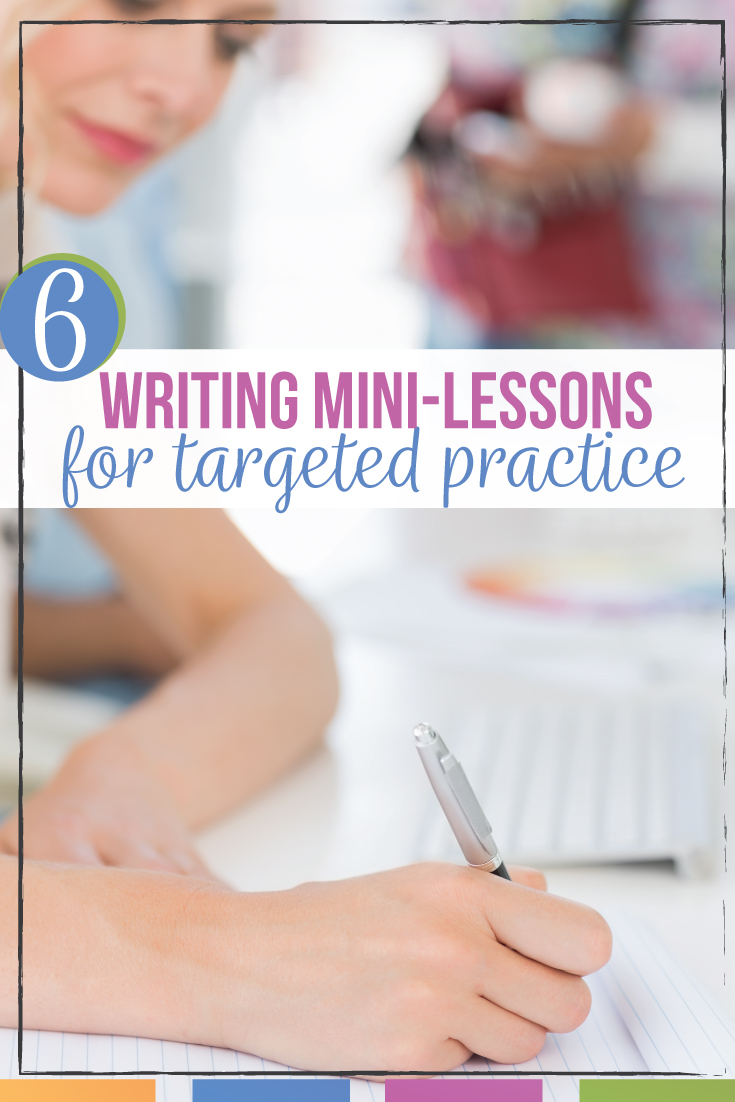
High school English mini-lessons often support writing, and such activities are easy to connect to other lessons. My writing bundle contains various lessons with ample tools to support student writers. That bundle carries over the messages that I wrote in this post concerning mini-lessons.
Are you interested in more mini writing lessons? My Pinterest board for writing contains ideas for mini lessons for writing from around the web.

